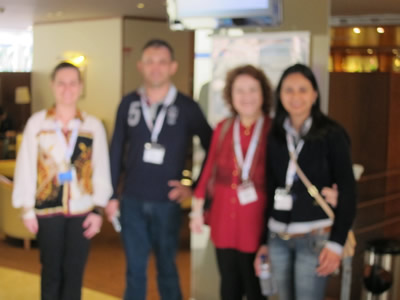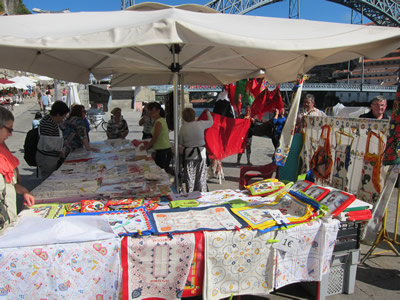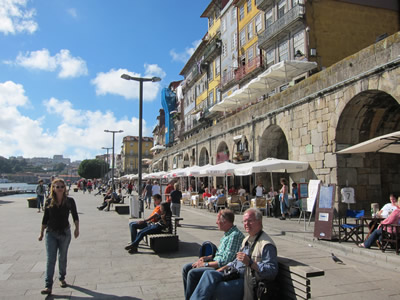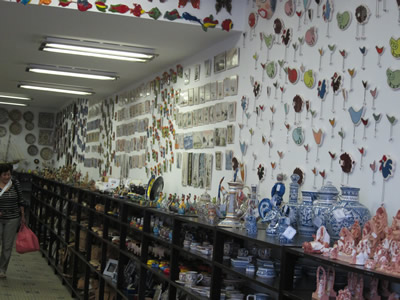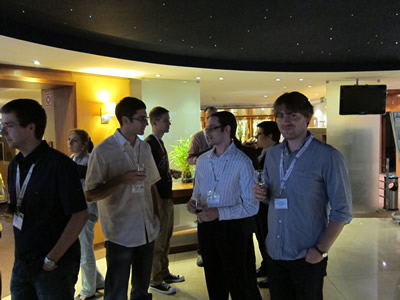SENSORDEVICES 2023 - The Fourteenth International Conference on Sensor Device Technologies and Applications
September 25, 2023 - September 29, 2023
SENSORDEVICES 2023: Call for Papers
Due to multiple requests, the submission deadline has been moved.
Onsite and Online Options: In order to accommodate a large number of situations, we are offering the option for either physical presence or virtual participation (pdf slides or pre-recorded videos).
Most of the sensor-oriented research and industry initiatives are focusing on sensor networks, data security, exchange protocols, energy optimization, and features related to intermittent connections. Recently, the concept of Internet-of-things gathers attention, especially when integrating IPv4 and IIPv6 networks. The event SENSORDEVICES 2023, The Fourteenth International Conference on Sensor Device Technologies and Applications, continues a series of events focusing on sensor devices themselves, the technology-capturing style of sensors, special technologies, signal control and interfaces, and particularly sensors-oriented applications. The evolution of the nano-and microtechnologies, nanomaterials, and the new business services make the sensor device industry and research on sensor-themselves very challenging.
We welcome technical papers presenting research and practical results, position papers addressing the pros and cons of specific proposals, such as those being discussed in the standard fora or in industry consortia, survey papers addressing the key problems and solutions on any of the above topics short papers on work in progress, and panel proposals.
We solicit both academic, research, and industrial contributions. We welcome technical papers presenting research and practical results, position papers addressing the pros and cons of specific proposals, such as those being discussed in the standard fora or in industry consortia, survey papers addressing the key problems and solutions on any of the above topics short papers on work in progress, and panel proposals.
Industrial presentations are not subject to the format and content constraints of regular submissions. We expect short and long presentations that express industrial position and status.
Tutorials on specific related topics and panels on challenging areas are encouraged.
The topics suggested by the conference can be discussed in term of concepts, state of the art, research, standards, implementations, running experiments, applications, and industrial case studies. Authors are invited to submit complete unpublished papers, which are not under review in any other conference or journal in the following, but not limited to, topic areas.
All topics and submission formats are open to both research and industry contributions.
SENSORDEVICES 2023 conference tracks:
Trends on sensing devices and applications
Touch sensing devices; Low-cost devices; Ultra-low power devices; Nanosensors; Super-sensors; IoT (internet of Things) devices; Clothes-based sensors; Wearable multi-channel acoustic headsets; Aerial and underwater drones; Telepresence robots; Adaptive sensing filters; Lenticular arrays for augmented reality; Integrated micro-sensor nodes; Built-in current sensors for soft errors; Smart cities using virtual sensors; Real-time super-resolution in infrared cameras; Body feature trackers; Crowd sensing devices and applications; Deep structured models; Semantic segmentation; Opportunistic data collection; Mobile sensing applications; Image reconstruction apps; Parsing ground and aerial Images; Slow and steady feature analysis; Active multi-view recognition; Decoding physical sensation; Device functions based on Biomimetic/Bioinspired characteristics
Sensor devices
Movement sensors (acceleration, rotation, speed, inclination, torque, vibrations, resonance); Atmosphere sensors (gas, oxygen, temperature, moisture, vacuum, pressure, wind); Position sensors (displacement, position, proximity, level, gap); Liquid sensors (flow, moisture, humidity, pH, pressure); Sound sensors (acoustic, ultrasonic, resonance); Technology-oriented sensors (nanosensors, optical, chemical, magnetic, biosensors)
Ultrasonic and Piezosensors
Design; Technologies; Signal conditioning; Applications
Magnetic sensors
Magnetic Sensors and actuators including, Hall-effect devices, magnetometers, magnetoimpedance sensors, magnetoresistance sensors, magnetoelastic sensors; Magnetic measurements & instrumentation, measurement standards; Smart materials and composites for wireless and non-destructive control including tuneable metamaterials; Magnetic sensors applications including biomedicine, electronic surveillance, electrical engineering, informatics, magnetic recording, construction monitoring, automobile and aircraft industries among others applications; Magnetic materials for magnetic sensors and actuators.
Photonics
Photonics-based sensors; Optoelectronics; Photonics-based metrology and instrumentation; Photonic integrated circuits; Opto-electro-mechanical sensors and systems
Infrared
Infrared sensing; Passive infrared sensors; Infrared proximity sensors; Infrared temperature sensors; Infrared motion sensors; Infrared sonics; Pyroelectric infrared
Gas Sensors
Non-Dispersive Infrared Gas Sensors; Electrochemical Gas Sensors; Optical Gas Sensors; Gas Sensors Applications: Health & Safety; Environmental Monitoring; Water & Waste Treatment ; Aerospace & Automobile Industries; Materials for Gas Sensors; Physical, Chemical and Biological Methods in Gas Sensing; Micro and Nano Technology in Gas Sensing.
Geosensors
Geosensor networks; Monitoring geographic space change, Tracking moving objects; Spatiotemporal sensors; Motion imagery records and analysis; Geovisualization; Application of geosensor networks
Sensor device technologies
Energy harvesting for autonomous sensors; Smart sensors; Embedded sensors; Nanomaterials for sensors; Nanowire sensors; Nanoparticule-based technologies; Ultrasonic technologies; Film-bases sensors; Resonant systems; Optical interferometry; Micro-and nanofabrication; Coating materials
Sensors signal conditioning and interfacing circuits
Direct sensor-to-microcontroller interfacing; ASICs and ICs for sensors; Signal conditioning; Signal processing; Sensors buses and interfaces; Multi-sensor signal conditioning and sensor arrays; Smart sensor interfaces; Digital and analog sensor interfaces; Universal sensors and transducers interface
Medical devices and sensors applications
Design and technologies for medical devices and sensors; Specialized sensors: EEG, ECG, accelerometers, pressure sensors, temperature sensors; Body sensors; Wireless body area networks
Sensors domain-oriented devices, technologies, and applications
Environmental sensors; Bridges and civil construction sensors; Security sensors; Surveillance sensors; Space sensors; Image sensors
Sensor-based localization and tracking technologies
Distributed and cooperative methods for ad hoc sensor networks; Measurement techniques (RSS, TOA, TDOA, etc.); Indoor/outdoor localization and tracking; Localization and tracking using satellites (GPS, Galileo); Radars; Remote sensing
Sensors and Transducers for Non-Destructive Testing
Ultrasonic Transducers for NDT; Ground Penetrating Radars; Acoustic Guided Waves Transducers; Piezoelectric and Acoustic Materials for Transducers Applications; Fluxgate and Magneto Inductive Sensors; Optical Fiber Sensors; Eddy Current Sensors.
Deadlines:
Submission | Aug 01, 2023 |
Notification | Aug 20, 2023 |
Registration | Sep 05, 2023 |
Camera ready | Sep 05, 2023 |
Deadlines differ for special tracks. Please consult the conference home page for special tracks Call for Papers (if any).
INSTRUCTION FOR THE AUTHORS
Authors of selected papers will be invited to submit extended versions to one of the IARIA Journals.
Publisher: XPS (Xpert Publishing Services)
Archived: ThinkMindTM Digital Library (free access)
Prints available at Curran Associates, Inc.
How to submit to appropriate indexes.
Only .pdf or .doc files will be accepted for paper submission. All received submissions will be acknowledged via an automated system.
Contribution types
- regular papers [in the proceedings, digital library]
- short papers (work in progress) [in the proceedings, digital library]
- ideas: two pages [in the proceedings, digital library]
- extended abstracts: two pages [in the proceedings, digital library]
- posters: two pages [in the proceedings, digital library]
- posters: slide only [slide-deck posted on www.iaria.org]
- presentations: slide only [slide-deck posted on www.iaria.org]
- demos: two pages [posted on www.iaria.org]
FORMATS
Only .pdf or .doc files will be accepted for paper submission. All received submissions will be acknowledged via an automated system.
Final author manuscripts will be 8.5" x 11", not exceeding 6 pages; max 4 extra pages allowed at additional cost.
Helpful information for paper formatting for MS Word can be found here.
There is a community provided LaTeX template: the CTAN package iaria (with full IARIA formatting rules, including IARIA citation style, but for providing citation style it is tightly bound to pdflatex+biblatex+biber). In addition, there is also iaria-lite (not bound to pdflatex+biblatex+biber, but compatible with any TeX stack; thus, it cannot provide the IARIA citation formattings, but only the titlepage and content-related IARIA formatting rules). Based on the iaria package, there is a minimal working example as Overleaf template. When you are using the LaTeX templates, please still adhere to the additional editorial rules.
Slides-based contributions can use the corporate/university format and style.
Your paper should also comply with the additional editorial rules.
Once you receive the notification of contribution acceptance, you will be provided by the publisher an online author kit with all the steps an author needs to follow to submit the final version. The author kits URL will be included in the letter of acceptance.
We would recommend that you should not use too many extra pages, even if you can afford the extra fees. No more than 2 contributions per event are recommended, as each contribution must be separately registered and paid for. At least one author of each accepted paper must register to ensure that the paper will be included in the conference proceedings and in the digital library, or posted on the www.iaria.org (for slide-based contributions).
CONTRIBUTION TYPE
Regular Papers (up to 6-10 page article -6 pages covered the by regular registration; max 4 extra pages allowed at additional cost- ) (oral presentation)
These contributions could be academic or industrial research, survey, white, implementation-oriented, architecture-oriented, white papers, etc. They will be included in the proceedings, posted in the free-access ThinkMind digital library and sent for indexing. Please submit the contributions following the instructions for the regular submissions using the "Submit a Paper" button and selecting the appropriate contribution type. 12-14 presentation slides are suggested.
Short papers (work in progress) (up to 4 pages long) (oral presentation)
Work-in-progress contributions are welcome. These contributions represent partial achievements of longer-term projects. They could be academic or industrial research, survey, white, implementation-oriented, architecture-oriented, white papers, etc. Please submit the contributions following the instructions for the regular submissions using the "Submit a Paper" button and selecting the contribution type as work in progress. Contributors must follow the conference deadlines, describing early research and novel skeleton ideas in the areas of the conference topics. The work will be published in the conference proceedings, posted in the free-access ThinkMind digital library and sent for indexing. For more details, see the Work in Progress explanation page. 12-14 presentation slides are suggested.
Ideas contributions (2 pages long) (oral presentation)
This category is dedicated to new ideas in their very early stage. Idea contributions are expression of yet to be developed approaches, with pros/cons, not yet consolidated. Ideas contributions are intended for a debate and audience feedback. Please submit the contributions following the instructions for the regular submissions using the "Submit a Paper" button and selecting the contribution type as Idea. Contributors must follow the conference deadlines, describing early research and novel skeleton ideas in the areas of the conference topics. The work will be published in the conference proceedings, posted in the free-access ThinkMind digital library and sent for indexing. For more details, see the Ideas explanation page. 12-14 presentation slides are suggested.
Extended abstracts (2 pages long) (oral presentation)
Extended abstracts summarize a long potential publication with noticeable results. It is intended for sharing yet to be written, or further on intended for a journal publication. Please submit the contributions following the instructions for the regular submissions using the "Submit a Paper" button and selecting the contribution type as Extended abstract. Contributors must follow the conference deadlines, describing early research and novel skeleton ideas in the areas of the conference topics. The work will be published in the conference proceedings, posted in the free-access ThinkMind digital library and sent for indexing. 12-14 presentation slides are suggested.
Posters (paper-based, two pages long) (oral presentation)
Posters are intended for ongoing research projects, concrete realizations, or industrial applications/projects presentations. The poster may be presented during sessions reserved for posters, or mixed with presentation of articles of similar topic. A two-page paper summarizes a presentation intended to be a POSTER. This allows an author to summarize a series of results and expose them via a big number of figures, graphics and tables. Please submit the contributions following the instructions for the regular submissions using the "Submit a Paper" button and selecting the contribution type as Poster Two Pages. Contributors must follow the conference deadlines, describing early research and novel skeleton ideas in the areas of the conference topics. The work will be published in the conference proceedings, posted in the free-access ThinkMind digital library and sent for indexing. 8-10 presentation slides are suggested. Also a big Poster is suitable, used for live discussions with the attendees, in addition to the oral presentation.
Posters (slide-based, only) (oral presentation)
Posters are intended for ongoing research projects, concrete realizations, or industrial applications/projects presentations. The poster may be presented during sessions reserved for posters, or mixed with presentation of articles of similar topic. The slides must have comprehensive comments. This type of contribution only requires a 8-10 slide-deck. Please submit the contributions following the instructions for the regular submissions using the "Submit a Paper" button and selecting the contribution type as Poster (slide-only). The slide-deck will be posted, post-event, on www.iaria.org.
8-10 presentation slides are suggested. Also a big Poster is suitable, used for live discussions with the attendees, additionally to the oral presentation.
Presentations (slide-based, only) (oral presentation)
These contributions represent technical marketing/industrial/business/positioning presentations. This type of contribution only requires a 12-14 slide-deck. Please submit the contributions following the submission instructions by using the "Submit a Paper" button and selecting the contribution type as Presentation (slide-only). The slide-deck will be posted, post-event, on www.iaria.org.
12-14 presentation slides are suggested.
Demos (two pages) [posted on www.iaria.org]
Demos represent special contributions where a tool, an implementation of an application, or a freshly implemented system is presented in its alfa/beta version. It might also be intended for thsoe new application to gather the attendee opinion. A two-page summary for a demo is intended to be. It would be scheduled in special time spots, to ensure a maximum attendance from the participants. Please submit the contributions following the submission instructions by using the "Submit a Paper" button and selecting the contribution type as Demos. The Demos paper will be posted, post-event, on www.iaria.org.
Tutorial proposals
Tutorials provide overviews of current high interest topics. Proposals should be for 2-3 hour long. Proposals must contain the title, the summary of the content, and the biography of the presenter(s). The tutorial slide decks will be posted on the IARIA site.
Please send your proposals to tutorial proposal
Panel proposals
The organizers encourage scientists and industry leaders to organize dedicated panels dealing with controversial and challenging topics and paradigms. Panel moderators are asked to identify their guests and manage that their appropriate talk supports timely reach our deadlines. Moderators must specifically submit an official proposal, indicating their background, panelist names, their affiliation, the topic of the panel, as well as short biographies. The panel slide deck will be posted on the IARIA site.
Please send your proposals to panel proposal





